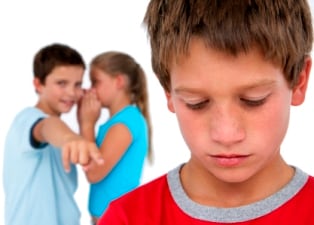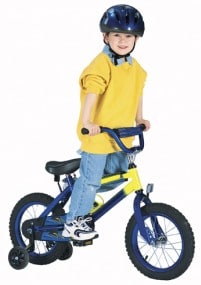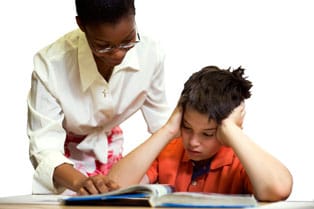| ||
|
Wednesday, November 30, 2011
ADHD and Defiance: Parenting “Difficult” Teens
Tuesday, November 29, 2011
Your Holiday Home
Your Holiday Home
 by Karen Sampson, MA
by Karen Sampson, MA
www.chadd.org
THE HOLIDAYS ARE HERE. The big questions, such as “which traditions does our family want to celebrate and continue?” have been answered. It’s the little things that are snowballing that need to be addressed now. Such as cleaning the house.
Develop routines
Maintaining a home is such a big project that a few generations ago, almost every family had a full-time home manager. Today, it is more common that single and partnered adults work outside the home. The challenge can still be met, even with AD/HD as part of the mix.
A secret resource for many CHADD members, keeping in mind that CHADD doesn’t endorse products or websites: FlyLady. So named for her love of fly fishing, FlyLady is all about “baby steps” and routines. She explains how to develop a routine to tackle the holiday season and the rest of the year, and her plans and control journals work well for anyone affected by AD/HD. Since you design your own routine with her guidance, it will fit the needs of your life. Other helpful websites include ServiceMaster and Queen of Clean.
Make a plan
Scout your dwelling and note what needs the most work, what needs the least work, and the best hiding places for stuff. (That includes cramming things under the bed—but only for quick cleanings during the holidays.)
Set the timer
Once there is a plan, set the kitchen timer for five, ten or fifteen minutes, and attack the first room. Pick up, stuff away, clear out of sight. When the timer dings, reset it for the next room, whether the first is done or not. Repeat the picking-up in the second room. Ding; same for the third. Set the timer again, grab something to drink or nibble and sit. Rest for the fourth round. Ding, and you’re back to the first room. Repeat until each room is picked up, dusted, and vacuumed, and any additional scrubbing is completed. Breaking it up over a couple days or a week is a good thing, too.
Handy tips
Leave a second garbage bag at the bottom of the pail, under the current one. That way you have one handy in a pinch without having to hunt for it.
Keep one extra of whatever—laundry soap, can of soup, package of paper towels—on hand. Don’t fill your cupboards with more than you need, but make sure you have a back-up at the ready so you don’t lose your stride.
Keep all cleaning supplies together—a mop bucket makes a great container to stick everything in so you can move from room to room quickly.
If you use it in that room, find a place for it to live in that room. That goes for brooms (kitchen pantry), vacuums (living room closet), laptop computers and accessories (family room entertainment center), and tablecloths (dining room china cabinet). This works well with cleaning supplies, too (though if there are small children in your life, perhaps up high in a cabinet). Suggestions from CHADD members
Suggestions from CHADD members
Get out of having the celebration at your house. Consider co-hosting family events at another relative’s house.
Make running lists—notebooks and personal data assistants are great for this. Make a list for everything from groceries to library books, and keep lists in one place for easy reference.
Limit your number of guests. A dinner party of six is more manageable than twenty-six. Since this is a holiday season, make use of the time by having two small dinner parties with different guests or one intimate party and then making reservations for the larger group at a favorite restaurant.
Call your favorite grocery store and find out about its holiday meals. Many prepare the entire meal at a reasonable cost. Order ahead, pick it up the morning of your holiday meal—and serve in your own dishes!
Online shopping is good. If the online store includes gift-wrapping, go for it! Have gifts sent to their recipients rather than to you. One wise member pointed out that wrapping gifts as soon as you get them helps to avoid the 3 a.m. crunch before the big day.
As one CHADD member wrote to us, “Change the expectations so the holiday works for you, not the other way around.”
If all else fails…
One CHADD member wrote that he once had a stack of newspapers piling up in the dining room, evidently for a couple of years. As company was coming rather soon, he struck upon a plan: He placed a board across the tops of the piles and draped a holiday tablecloth over it. The piles were successfully hidden and the set-up “didn’t look bad, really.”
Except that it stayed that way for another four years before finally being cleared away.
Karen Sampson, MA, writes from Hanover, Maryland.
Wednesday, November 9, 2011
Difficult Peer Relationships
 ADHD can have many effects on a child's development. It can make childhood friendships, or peer relationships, very difficult. These relationships contribute to children's immediate happiness and may be very important to their long-term development.
ADHD can have many effects on a child's development. It can make childhood friendships, or peer relationships, very difficult. These relationships contribute to children's immediate happiness and may be very important to their long-term development.
Children with ADHD might have difficulty in their peer relationships, for example, being rejected by peers or not having close friends. In some cases, children with peer problems may also be at higher risk for anxiety, behavioral and mood disorders, substance abuse and delinquency as teenagers.
- Parents of children with a history of ADHD report almost 3 times as many peer problems as those without a history of ADHD (21.1% vs. 7.3%).1
- Parents report that children with a history of ADHD are almost 10 times as likely to have difficulties that interfere with friendships (20.6% vs. 2.0%).1
How does ADHD interfere with peer relationships?
Exactly how ADHD contributes to social problems is not fully understood. Several studies have found that children with predominantly inattentive ADHD may be perceived as shy or withdrawn by their peers. Research strongly indicates that aggressive behavior in children with symptoms of impulsivity/hyperactivity may play a significant role in peer rejection. In addition, other behavioral disorders often occur along with ADHD. Children with ADHD and other disorders appear to face greater impairments in their relationships with peers.
Having ADHD does not mean a person has to have poor peer relationships.
Not everyone with ADHD has difficulty getting along with others. For those who do, many things can be done to improve the person's relationships. The earlier a child's difficulties with peers are noticed, the more successful intervention may be. Although researchers have not provided definitive answers, some things parents might consider as they help their child build and strengthen peer relationships are:
- Recognize the importance of healthy peer relationships for children. These relationships can be just as important as grades to school success.
- Maintain on-going communication with people who play important roles in your child's life (such as teachers, school counselors, after-school activity leaders, health care providers, etc.). Keep up-dated on your child's social development in community and school settings.
- Involve your child in activities with his or her peers. Communicate with other parents, sports coaches and other involved adults about any progress or problems that may develop with your child.
- Peer programs can be helpful, particularly for older children and teenagers. Schools and communities often have such programs available. You may want to discuss the possibility of your child's participation with program directors and your child's care providers.
Risk of Injuries
 Children and adolescents with ADHD can have more frequent and severe injuries than peers without ADHD.
Children and adolescents with ADHD can have more frequent and severe injuries than peers without ADHD.
Research indicates that children with ADHD are significantly more likely to:
- Be injured as pedestrians or while riding a bicycle
- Receive head injuries
- Injure more than one part of the body
- Be hospitalized for accidental poisoning
- Be admitted to intensive care units or have an injury result in disability
Further research is needed to understand what role ADHD symptoms play in the risk of injuries and other disorders that may occur with ADHD. For example, a young child with ADHD may not look for oncoming traffic while riding a bicycle or crossing the street, or may engage in high-risk physical activity without thinking of the possible consequences. Teenagers with ADHD who drive may have more traffic violations and accidents and twice as likely to have their driver’s licenses suspended than drivers without ADHD.
Much of what is already known about injury prevention may be particularly useful for people with ADHD.
- Ensure bicycle helmet use. Remind children as often as necessary to watch for cars and to avoid unsafe activities.
- Supervise children when they are involved in high-risk activities or are in risky settings, such as when climbing or when in or around a swimming pool.
- Keep potentially harmful household products, tools, equipment and objects out of the reach of young children.
- Teens with ADHD may need to limit the amount of music listened to in the car while driving, drive without passengers and/or keep the number of passengers to a chosen few, plan trips well ahead of time, avoid alcohol and drug use and cellular phone usage.
- Parents may want to enroll their teens in driving safety courses before they get their driver’s license.
- For more injury prevention tips, visit CDC’s Injury Center.
Oppositional Defiant Disorder
Oppositional Defiant Disorder (ODD) is one of the most common disorders occurring with ADHD. ODD usually starts before age eight, but no later than early adolescence. Symptoms may occur most often with people the individual knows well, such as family members or a regular care provider. These behaviors are present beyond what are expected for the child’s age, and result in significant difficulties in school, at home, and/or with peers.
Examples of ODD behaviors include:
- Losing one’s temper a lot
- Arguing with adults or refusing to comply with adults’ rules or requests
- Often getting angry or being resentful or vindictive
- Deliberately annoying others; easily becoming annoyed with others
- Often blaming other people for one’s own mistakes or misbehavior
Learning Disorder
 Recently released data from the 1997-98 National Health Interview Survey suggests roughly half of those youth 6-11 years old diagnosed with ADHD may also have a Learning Disorder (LD). The combination of attention problems caused by ADHD and LD can make it particularly hard for a child to succeed in school. Properly diagnosing each disorder is crucial. Appropriate and timely interventions to address ADHD and LD should follow diagnosis. The nature and course of treatment for ADHD and LD may be different, and different types of providers may be involved. Working with health care professionals to determine appropriate referrals and treatment is the best way to make informed decisions for an individual dealing with ADHD and a learning problem.
Recently released data from the 1997-98 National Health Interview Survey suggests roughly half of those youth 6-11 years old diagnosed with ADHD may also have a Learning Disorder (LD). The combination of attention problems caused by ADHD and LD can make it particularly hard for a child to succeed in school. Properly diagnosing each disorder is crucial. Appropriate and timely interventions to address ADHD and LD should follow diagnosis. The nature and course of treatment for ADHD and LD may be different, and different types of providers may be involved. Working with health care professionals to determine appropriate referrals and treatment is the best way to make informed decisions for an individual dealing with ADHD and a learning problem.
Conduct Disorder
Conduct Disorder (CD) is a behavioral pattern characterized by aggression toward others and serious violations of rules, laws, and social norms. These behaviors often lead to delinquency or incarceration. Increased injuries and strained peer relationships are also common in this population. The symptoms of CD are apparent in several settings in the person’s life (e.g., at home, in the community and at school).
While CD is less common than Oppositional Defiant Disorder, it is severe and highly disruptive to the person’s life and to others in his/her life. It is also very challenging to treat. A mental health professional should complete evaluations for CD where warranted, and a plan for intervention should be implemented as early as possible.
Read more at http://www.cdc.gov/ncbddd/adhd/conditions.html#peer. From Centers for Disease Control and Prevention